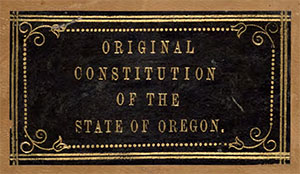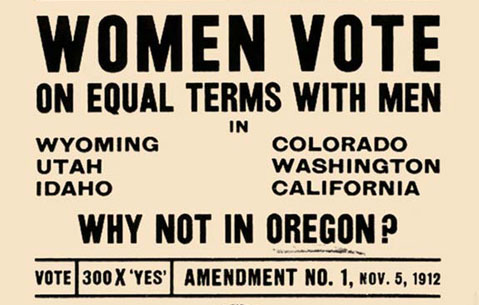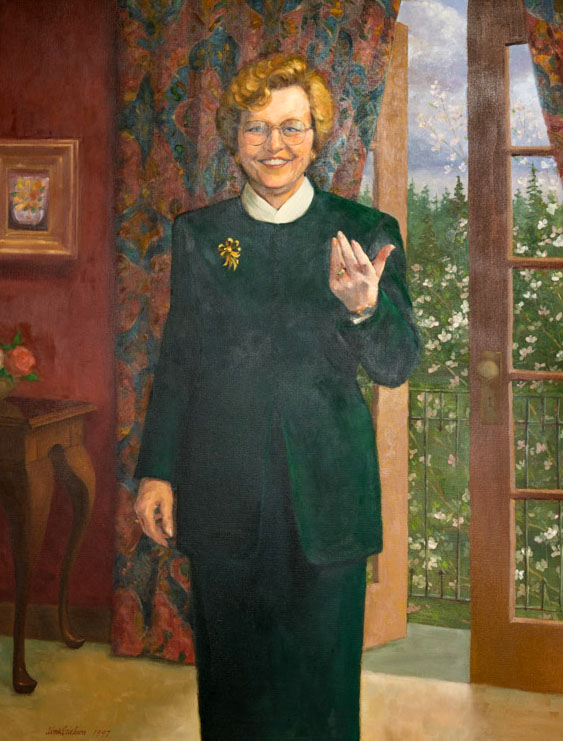The Evolution of Women's Rights in Oregon
Page Content
1850
Donation Land Claim Act. Allows married women to claim land in their own names. The Act was passed prior to any U.S. treaty negotiations with Native peoples in the area, for whom Oregon had been home for thousands of years. Only “white settlers” and “American half-breed Indians” could claim land, and the Act excluded all non-U.S. citizens, including Native peoples (who were not U.S. citizens), Blacks, and Hawaiians.
1857

Oregon State Constitutional Convention. Declares that only white men can vote. The convention produced the
original Oregon Constitution (
View transcribed text). The delegates to the convention reflected the racist attitudes of the white citizens of the territory. The cover title of the original document is shown here. (Oregon State Archives Image)
1864
Federal law allows “competent” Native women to testify in trials.
1866
Oregon passes miscegenation laws prohibiting whites from marrying African Americans, Chinese Americans, Native Hawaiians, and other Native peoples.
1870
First Oregon woman suffrage organizations form in Albany and Salem.
1871

Susan B. Anthony tours the Pacific Northwest with Abigail Scott Duniway. Susan B. Anthony is shown here ca. 1855. (Courtesy of Wikimedia Commons)
1871-1887
Abigail Scott Duniway publishes
The New Northwest, a women’s rights newspaper.
November 1872
Mrs. Mary Beatty, an African American woman living in Portland, joins fellow Oregonians Abigail Scott Duniway, Maria Hendee, and Mrs. M.A. Lambert, in casting their votes in the presidential election. The judge does not count their votes.
1878
All Oregon taxpayers, regardless of gender, may vote in school elections.
1878
Married Women’s Property Act. Opens the way for married women in Oregon to own their own property and enter business arrangements without their husband.
1884
First Oregon vote on woman suffrage. For: 11,223 (28 percent); Against: 28,176.
1893

Oregon allows women to be “eligible to all educational offices within the state.” Previously, women were expected to serve only as teachers. A teacher stands at the head of a Marion County class ca. 1900 in this photo. (Oregon State Archives Image)
1896
Oregon Supreme Court case
State Ex Rel. v. Stevens declares the 1893 law making women eligible for educational office unconstitutional.
1898
Oregon Supreme Court case
Harris v. Burr upholds taxpaying women’s right to vote in school elections.
1900
Second Oregon vote on woman suffrage. For: 26,255 (48 percent); Against: 28,402.
1902
Voters adopt the famous Oregon System of initiative and referendum.
1903
Oregon makes it illegal for certain industries, such as factories and laundries, to have women work for more than ten hours per day.
1905

The National American Woman Suffrage Association (NAWSA) holds its national convention in Portland in conjunction with the Lewis and Clark Exposition. Shown here, visitors walk past the Agricultural Palace at the 1905 Lewis and Clark Exposition in Portland. (Courtesy of Al Staehli)
1906
Third Oregon vote on woman suffrage. For: 36,902 (44 percent); Against: 47,075.
1907-1922
Oregon women who marry noncitizens lose their citizenship status. The federal Expatriation Act of 1907, which enacted this status, left affected women with forfeited constitutional rights and subject to deportation. The Cable Act of 1922 nullified this for all except women who married men ineligible for citizenship.
1908
Fourth Oregon vote on woman suffrage. For: 36,858 (39 percent); Against: 58,670.
1910
Fifth Oregon vote on woman suffrage. For: 35,270 (37 percent); Against: 59,065.
1912

Sixth and final Oregon vote on woman suffrage. For: 61,265 (52%); Against: 57,104. Shown here, a handbill calls on Oregon voters to approve woman suffrage in the 1912 election. (Courtesy of University of Oregon Library)
1914
Marian B. Towne, a Jackson County Democrat, is the first woman elected to the Oregon House of Representatives.
1915
Kathryn Clarke, a Douglas County Republican, is the first woman elected to the Oregon Senate.
1916
Voters in the City of Umatilla elected an all-female slate of candidates including Mayor Laura J. Starcher, who replaced her husband.
January 1920
Oregon becomes the twenty-fifth state to ratify the 19th Amendment.
October 1920
Marie Equi, M.D., begins her prison term for protesting World War I.
November 1920
Esther Pohl Lovejoy, Democrat from Oregon’s Third District, is the first woman to run for U.S. Congress from Oregon; she gains 44 percent of the vote.
1921

Oregon voters approve jury service for women. Opponents to woman suffrage had argued that women were too sentimental to vote or serve on juries. This 1915 drawing by Kenneth Russell Chamberlain for
Puck magazine pokes fun at that idea.
See enlarged image at the Library of Congress.
1924
Federal Indian Citizenship Act. Makes U.S. citizenship possible for all Native women.
1937
Nan Wood Honeyman becomes the first Oregon woman elected to the US House of Representatives.
1952
McCarran Walter Act. Enables first generation Asian American women to acquire citizenship.
1960-1967
Maurine Neuberger is the first and only woman to represent Oregon in the U.S. Senate.
1960-1970s
Women in the Oregon legislature work to pass laws addressing women’s unequal citizenship in marriage, work, health, and legal status.
1976
Mae Yih (born Chih Feng Dunn) becomes the first Chinese American to serve in a state Senate in the United States. She served in both Oregon House and Senate.
1977
Norma Paulus becomes first woman elected to statewide office as Secretary of State.
1979
Oregon Supreme Court case
Gunther v. Washington County expands equal pay for equal work toward comparable worth.
1982
Betty Roberts becomes the first woman on the Oregon Supreme Court.
1985
Vera Katz is first woman to serve as Speaker of the Oregon House of Representatives. Of Portland's five Jewish mayors, Vera Katz, who was mayor from 1993 to 2005, is the only woman.
1990
Jackie Taylor is the first Native American elected to the Oregon House.
1991-1995

Barbara Roberts is the first woman to serve as Governor of Oregon. Shown here is a portrait of Roberts by Aimee Erickson. The portrait hangs in the Oregon State Capitol. (Oregon State Archives Image)
1996
Avel Louise Gordly becomes the first African-American woman to be elected to the Oregon Senate.
1998
Oregon becomes the first state in the nation to vote exclusively by mail.
Jackie Winters is elected to the Oregon House of Representatives. She was the first African-American Republican ever to serve In the Oregon Legislative Assembly. In 2017, Winters was elected as Senate Minority Leader and became the first African-American legislative leader in Oregon.
2002
Susan Castillo is the first female Lantinx official elected to statewide office as the Superintendent of Public Instruction.
2012
Ellen Rosenblum becomes the state’s first female attorney general and the first Jewish person to hold the office.
2016
Teresa Alonso Leon is the first Latina immigrant elected to the Oregon House.
2018
Susheela Jayapal becomes the first South Asian American elected in Oregon to Multnomah County Board of Commissioners.
2019
Jo Ann Hardesty becomes the first African-American woman to serve on the Portland City Council.
Next:
Ratification of the 19th Amendment >